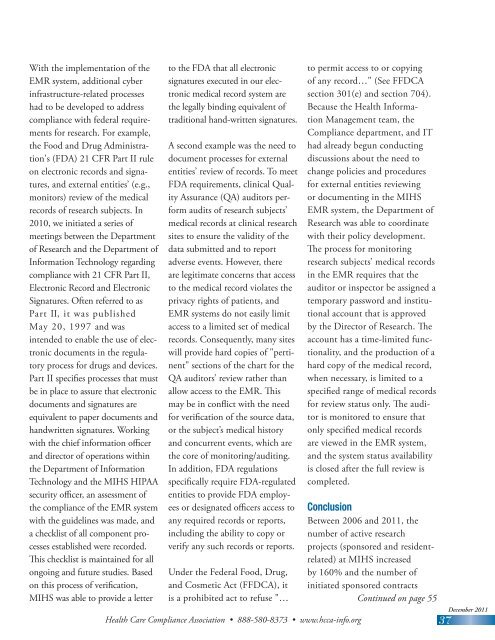Quality of the estimate. December, p. 47 - Health Care Compliance ...
Quality of the estimate. December, p. 47 - Health Care Compliance ...
Quality of the estimate. December, p. 47 - Health Care Compliance ...
Create successful ePaper yourself
Turn your PDF publications into a flip-book with our unique Google optimized e-Paper software.
With <strong>the</strong> implementation <strong>of</strong> <strong>the</strong><br />
EMR system, additional cyber<br />
infrastructure-related processes<br />
had to be developed to address<br />
compliance with federal requirements<br />
for research. For example,<br />
<strong>the</strong> Food and Drug Administration's<br />
(FDA) 21 CFR Part II rule<br />
on electronic records and signatures,<br />
and external entities’ (e.g.,<br />
monitors) review <strong>of</strong> <strong>the</strong> medical<br />
records <strong>of</strong> research subjects. In<br />
2010, we initiated a series <strong>of</strong><br />
meetings between <strong>the</strong> Department<br />
<strong>of</strong> Research and <strong>the</strong> Department <strong>of</strong><br />
Information Technology regarding<br />
compliance with 21 CFR Part II,<br />
Electronic Record and Electronic<br />
Signatures. Often referred to as<br />
Part II, it was published<br />
May 20, 1997 and was<br />
intended to enable <strong>the</strong> use <strong>of</strong> electronic<br />
documents in <strong>the</strong> regulatory<br />
process for drugs and devices.<br />
Part II specifies processes that must<br />
be in place to assure that electronic<br />
documents and signatures are<br />
equivalent to paper documents and<br />
handwritten signatures. Working<br />
with <strong>the</strong> chief information <strong>of</strong>ficer<br />
and director <strong>of</strong> operations within<br />
<strong>the</strong> Department <strong>of</strong> Information<br />
Technology and <strong>the</strong> MIHS HIPAA<br />
security <strong>of</strong>ficer, an assessment <strong>of</strong><br />
<strong>the</strong> compliance <strong>of</strong> <strong>the</strong> EMR system<br />
with <strong>the</strong> guidelines was made, and<br />
a checklist <strong>of</strong> all component processes<br />
established were recorded.<br />
This checklist is maintained for all<br />
ongoing and future studies. Based<br />
on this process <strong>of</strong> verification,<br />
MIHS was able to provide a letter<br />
to <strong>the</strong> FDA that all electronic<br />
signatures executed in our electronic<br />
medical record system are<br />
<strong>the</strong> legally binding equivalent <strong>of</strong><br />
traditional hand-written signatures.<br />
A second example was <strong>the</strong> need to<br />
document processes for external<br />
entities’ review <strong>of</strong> records. To meet<br />
FDA requirements, clinical <strong>Quality</strong><br />
Assurance (QA) auditors perform<br />
audits <strong>of</strong> research subjects’<br />
medical records at clinical research<br />
sites to ensure <strong>the</strong> validity <strong>of</strong> <strong>the</strong><br />
data submitted and to report<br />
adverse events. However, <strong>the</strong>re<br />
are legitimate concerns that access<br />
to <strong>the</strong> medical record violates <strong>the</strong><br />
privacy rights <strong>of</strong> patients, and<br />
EMR systems do not easily limit<br />
access to a limited set <strong>of</strong> medical<br />
records. Consequently, many sites<br />
will provide hard copies <strong>of</strong> "pertinent"<br />
sections <strong>of</strong> <strong>the</strong> chart for <strong>the</strong><br />
QA auditors’ review ra<strong>the</strong>r than<br />
allow access to <strong>the</strong> EMR. This<br />
may be in conflict with <strong>the</strong> need<br />
for verification <strong>of</strong> <strong>the</strong> source data,<br />
or <strong>the</strong> subject’s medical history<br />
and concurrent events, which are<br />
<strong>the</strong> core <strong>of</strong> monitoring/auditing.<br />
In addition, FDA regulations<br />
specifically require FDA-regulated<br />
entities to provide FDA employees<br />
or designated <strong>of</strong>ficers access to<br />
any required records or reports,<br />
including <strong>the</strong> ability to copy or<br />
verify any such records or reports.<br />
Under <strong>the</strong> Federal Food, Drug,<br />
and Cosmetic Act (FFDCA), it<br />
is a prohibited act to refuse "…<br />
<strong>Health</strong> <strong>Care</strong> <strong>Compliance</strong> Association • 888-580-8373 • www.hcca-info.org<br />
to permit access to or copying<br />
<strong>of</strong> any record…" (See FFDCA<br />
section 301(e) and section 704).<br />
Because <strong>the</strong> <strong>Health</strong> Information<br />
Management team, <strong>the</strong><br />
<strong>Compliance</strong> department, and IT<br />
had already begun conducting<br />
discussions about <strong>the</strong> need to<br />
change policies and procedures<br />
for external entities reviewing<br />
or documenting in <strong>the</strong> MIHS<br />
EMR system, <strong>the</strong> Department <strong>of</strong><br />
Research was able to coordinate<br />
with <strong>the</strong>ir policy development.<br />
The process for monitoring<br />
research subjects’ medical records<br />
in <strong>the</strong> EMR requires that <strong>the</strong><br />
auditor or inspector be assigned a<br />
temporary password and institutional<br />
account that is approved<br />
by <strong>the</strong> Director <strong>of</strong> Research. The<br />
account has a time-limited functionality,<br />
and <strong>the</strong> production <strong>of</strong> a<br />
hard copy <strong>of</strong> <strong>the</strong> medical record,<br />
when necessary, is limited to a<br />
specified range <strong>of</strong> medical records<br />
for review status only. The auditor<br />
is monitored to ensure that<br />
only specified medical records<br />
are viewed in <strong>the</strong> EMR system,<br />
and <strong>the</strong> system status availability<br />
is closed after <strong>the</strong> full review is<br />
completed.<br />
Conclusion<br />
Between 2006 and 2011, <strong>the</strong><br />
number <strong>of</strong> active research<br />
projects (sponsored and residentrelated)<br />
at MIHS increased<br />
by 160% and <strong>the</strong> number <strong>of</strong><br />
initiated sponsored contracts<br />
Continued on page 55<br />
<strong>December</strong> 2011<br />
37

















